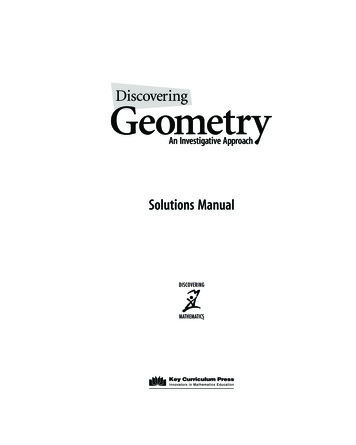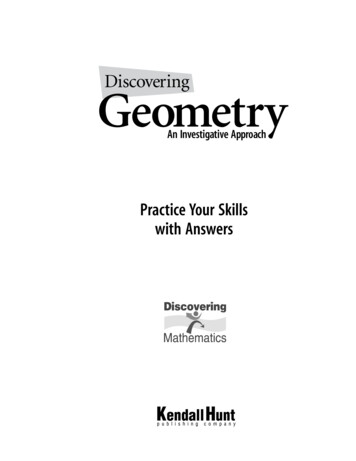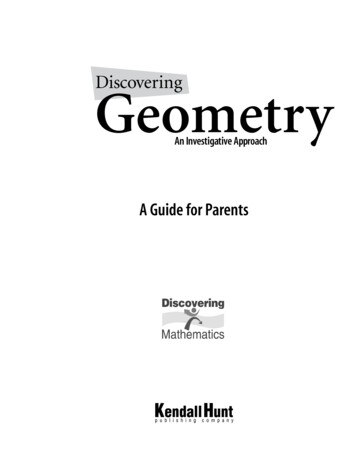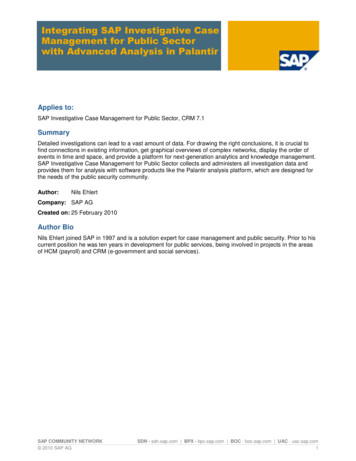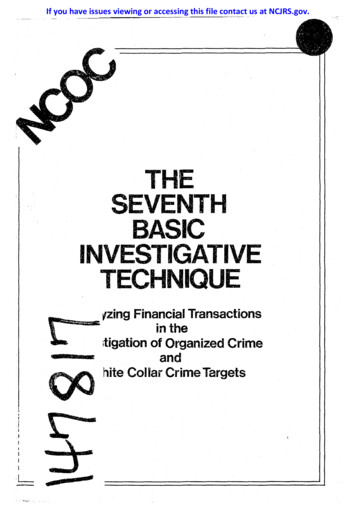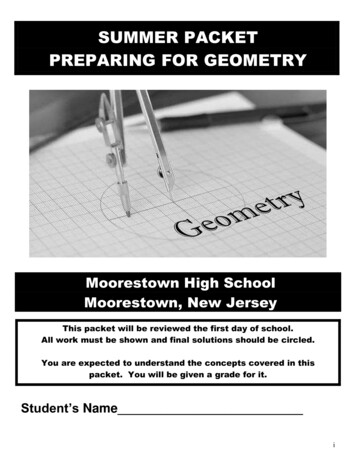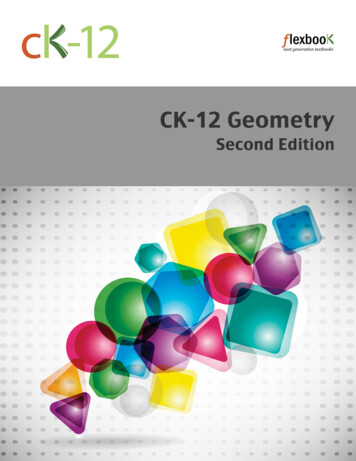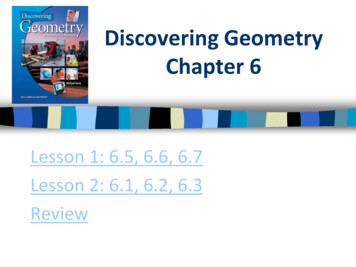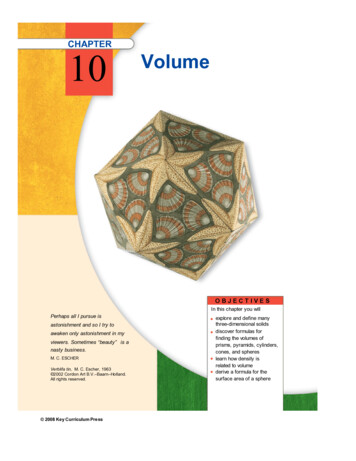
Transcription
hapter 10 Page rtingCourses/DG4E/.CHAPTER10VolumeOBJECTIVESIn this chapter you willPerhaps all I pursue isastonishment and so I try toawaken only astonishment in myviewers. Sometimes “beauty” is anasty business.M. C. ESCHERVerblifa tin, M. C. Escher, 1963 2002 Cordon Art B.V.–Baarn–Holland.All rights reserved. 2008 Key Curriculum Pressexplore and define manythree-dimensional solidsdiscover formulas forfinding the volumes ofprisms, pyramids, cylinders,cones, and sphereslearn how density isrelated to volumederive a formula for thesurface area of a sphere
ewer/Lesson.htmThe Geometry of SolidsL E S S O N10.1Most of the geometric figures you have worked with so far have been flat planeEverything in natureadheres to the cone,the cylinder, and the cube.figures with two dimensions—base and height. In this chapter you will work withsolid figures with three dimensions—length, width, and height. Most real-worldsolids, like rocks and plants, are very irregular, but many others are geometric.Some real-world geometric solids occur in nature: viruses, oranges, crystals, theearth itself. Others are human-made: books, buildings, baseballs, soup cans,ice cream cones.PAUL CEZANNEScienceThree-dimensional geometry plays an important role inthe structure of molecules. For example, when carbonatoms are arranged in a very rigid network, they formdiamonds, one of the earth’s hardest materials. Butwhen carbon atoms are arranged in planes ofhexagonal rings, they form graphite, a soft materialused in pencil lead.Carbon atoms can also bond into very large molecules.Named fullerenes, after U.S. engineer BuckminsterFuller (1895–1983), these carbon molecules havethe same symmetry as a soccer ball, as shownat left. They are popularly called buckyballs.Researchers have recently discovered a similarphenomenon with gold atoms. Gold clustersof fewer than 16 atoms are flat, and clusters of more than 18 atomsform a pyramid, but clusters of 16, 17, or 18 form a hollow cage. Likebuckyballs, these hollow gold cages may be able to house other atoms,which may have applications in nanotechnology and medicine. For moreinformation, visit www.keymath.com/DG .520CHAPTER 10Volume 2008 Key Curriculum Press
ewer/Lesson.htmA solid formed by polygons that enclose a single region of space is called apolyhedron. The flat polygonal surfaces of a polyhedron are called its faces.Although a face of a polyhedron includes the polygon and its interior region, weidentify the face by naming the polygon that encloses it. A segment where two facesintersect is called an edge. The point of intersection of three or more edges iscalled a vertex of the polyhedron.Just as a polygon is classified by its number of sides, a polyhedron is classified byits number of faces. The prefixes for polyhedrons are the same as they are forpolygons with one exception: A polyhedron with four faces is called a tetrahedron.Here are some examples of polyhedrons.If each face of a polyhedron is enclosed by aregular polygon, and each face is congruent to theother faces, and the faces meet at each vertex inexactly the same way, then the polyhedron is calleda regular polyhedron. The regular polyhedronshown at right is called a regular dodecahedronbecause it has 12 faces. 2008 Key Curriculum PressLESSON 10.1 The Geometry of Solids521
ewer/Lesson.htmA prism is a special type of polyhedron, with two faces called bases, that arecongruent, parallel polygons. The other faces of the polyhedron, called lateralfaces, are parallelograms that connect the corresponding sides of the bases.The lateral faces meet to form the lateral edges. Each solid shown below is a prism.Prisms are classified by their bases. For example, a prism with triangular bases is atriangular prism, and a prism with hexagonal bases is a hexagonal prism.A prism whose lateral faces are rectangles is called a right prism. Its lateral edgesare perpendicular to its bases. A prism that is not a right prism is called an obliqueprism. The altitude of a prism is any perpendicular segment from one base to theplane of the other base. The length of an altitude is the height of the prism.A pyramid is another special type of polyhedron. Pyramids have only one base.As in a prism, the other faces are called the lateral faces, and they meet to form thelateral edges. The common vertex of the lateral faces is the vertex of the pyramid.Like prisms, pyramids are also classifiedby their bases. The pyramids of Egyptare square pyramids because they havesquare bases.The altitude of the pyramid is theperpendicular segment from its vertexto the plane of its base. The length of thealtitude is the height of the pyramid.522CHAPTER 10 Volume 2008 Key Curriculum Press
ewer/Lesson.htmPolyhedrons are geometric solids with flatsurfaces. There are also geometric solids thathave curved surfaces.One solid with a curved surface is a cylinder.Soup cans, compact discs (CDs), and plumbingpipes are shaped like cylinders. Like a prism, acylinder has two bases that are both paralleland congruent. Instead of polygons, however,the bases of cylinders are circles and theirinteriors. The segment connecting the centersof the bases is called the axis of the cylinder.The radius of the cylinder is the radius ofa base.If the axis of a cylinder is perpendicular to thebases, then the cylinder is a right cylinder. Acylinder that is not a right cylinder is anoblique cylinder.The altitude of a cylinder is any perpendicularsegment from the plane of one base to theplane of the other. The height of a cylinder isthe length of an altitude.Another type of solid with a curved surface is a cone. Funnels and ice cream conesare shaped like cones. Like a pyramid, a cone has a base and a vertex.The base of a cone is a circle and its interior. The radius of a cone is the radius ofthe base. The vertex of a cone is the point that is the greatest perpendiculardistance from the base. The altitude of a cone is the perpendicular segment fromthe vertex to the plane of the base. The length of the altitude is the height of acone. If the line segment connecting the vertex of a cone with the center of its baseis perpendicular to the base, then the cone is a right cone. 2008 Key Curriculum PressLESSON 10.1 The Geometry of Solids523
ewer/Lesson.htmA third type of solid with a curvedsurface is a sphere. Basketballs, globes,and oranges are shaped like spheres.A sphere is the set of all points in spaceat a given distance from a given point.You can think of a sphere as a threedimensional circle.The given distance is called the radiusof the sphere, and the given point is thecenter of the sphere. A hemisphere ishalf a sphere and its circular base. The circle that encloses the base of a hemisphereis called a great circle of the sphere. Every plane that passes through the center of asphere determines a great circle. All the longitude lines on a globe of Earth aregreat circles. The equator is the only latitude line that is a great circle.EXERCISES1. Complete this definition:A pyramid is awith oneface (called the base) and whose other faces (lateralfaces) areformed by segments connecting the vertices of the base to a commonpoint (the vertex) not on the base.For Exercises 2–9, refer to the figures below. All measurements are in centimeters.2. Name the bases of the prism.3. Name all the lateral faces of the prism.4. Name all the lateral edges of the prism.5. What is the height of the prism?6. Name the base of the pyramid.7. Name the vertex of the pyramid.8. Name all the lateral edges of the pyramid.9. What is the height of the pyramid?524CHAPTER 10 Volume 2008 Key Curriculum Press
ewer/Lesson.htmFor Exercises 10–22, match each real object with a geometry term. You may use ageometry term more than once or not at all.10. Tomb of Egyptian rulers11. Honeycomb12. Die13. Stop sign14. Holder for a scoop of ice cream15. Wedge or doorstop16. Moon17. Can of tuna fish18. Box of breakfast cereal19. Book20. Plastic bowl with lid21. Pup tentA. CylinderB. ConeC. Square prismD. Square pyramidE. SphereF. Triangular pyramidG. Octagonal prismH. Triangular prismI. Trapezoidal prismJ. Rectangular prismK. Heptagonal pyramidL. Hexagonal prismM. Hemisphere22. Ingot of silverFor Exercises 23–26, draw and label each solid. Use dashed lines to show the hidden edges.23. A triangular pyramid whose base is an equilateral triangular region (Use the propermarks to show that the base is equilateral.)24. A hexahedron with two trapezoidal faces25. A cylinder with a height that is twice the diameter of the base (Use x and 2x toindicate the height and the diameter.)26. A right cone with a height that is half the diameter of the baseFor Exercises 27–35, identify each statement as true or false. Sketch a counterexample foreach false statement or explain why it is false.27. A lateral face of a pyramid is always a triangular region.28. A lateral edge of a pyramid is always perpendicular to the base. 2008 Key Curriculum PressLESSON 10.1 The Geometry of Solids525
ewer/Lesson.htm29. Every slice of a prism cut parallel to the bases is congruent to the bases.30. When the lateral surface of a right cylinder is unwrapped and laid flat, it is arectangle.31. When the lateral surface of a right circular cone is unwrapped and laid flat, it isa triangle.32. Every section of a cylinder, parallel to the base, is congruent to the base.33. The length of a segment from the vertex of a cone to the circular base is theheight of the cone.34. The length of the axis of a right cylinder is the height of the cylinder.35. All slices of a sphere passing through the sphere’s center are congruent.36. Mini-Investigation An antiprism is a polyhedron with two congruent bases and lateralfaces that are triangles. Complete the tables below for prisms and antiprisms.Describe any relationships you see between the number of lateral faces, total faces,edges, and vertices of related prisms and antiprisms.526CHAPTER 10 Volume 2008 Key Curriculum Press
ewer/Lesson.htm37. Write a paragraph describing the visual tricks thatBelgian artist René Magritte (1898–1967) plays inhis painting at right.ReviewFor Exercises 38 and 39, how many cubes measuring1 cm on each edge will fit into the container?38. A box measuring 2 cm on each inside edge39. A box measuring 3 cm by 4 cm by 5 cm on theinside edges40. What is the maximum number of boxes measuring 1 cm by 1 cm by 2 cm that canfit within a box whose inside dimensions are 3 cm by 4 cm by 5 cm?41. For each net, decide whether it folds to make a box. If it does, copy the net andmark each pair of opposite faces with the same symbol.Piet Hein’s PuzzleIn 1936, while listening to a lecture on quantum physics, the Danish mathematicianPiet Hein (1905–1996) devised the following visual thinking puzzle:What are all the possible nonconvex solids that can be created by joining four or fewercubes face-to-face?A nonconvex polyhedron is a solid that has at least one diagonal that isexterior to the solid. For example, four cubes in a row, joined face-to-face,form a convex polyhedron. But four cubes joined face-to-face into an L-shapeform a nonconvex polyhedron.Use isometric dot paper to sketch the nonconvex solids that solve Piet Hein’spuzzle. 2008 Key Curriculum PressLESSON 10.1 The Geometry of Solids527
ewer/Lesson.htmEuler’s Formula forPolyhedronsIn this activity you will discover a relationshipamong the vertices, edges, and faces of apolyhedron. This relationship is calledEuler’s Formula for Polyhedrons, namedafter Leonhard Euler. Let’s first buildsome of the polyhedrons you learnedabout in Lesson 10.1.Toothpick Polyhedronstoothpicksmodeling clay,gumdrops, ordried peas528First, you’ll model polyhedrons using toothpicksas edges and using small balls of clay, gumdrops,or dried peas as connectors.Step 1CHAPTER 10 VolumeBuild and save the polyhedrons shown in parts a–d below and described inparts e–i on the top of page 531. You may have to cut or break some sticks.Share the tasks among the group. 2008 Key Curriculum Press
ewer/Lesson.htme. Build a tetrahedron.f. Build an octahedron.g. Build a nonahedron.h. Build at least two different-shaped decahedrons.i. Build at least two different-shaped dodecahedrons.Step 2Classify all the different polyhedrons your class built as prisms, pyramids, regularpolyhedrons, or just polyhedrons.Next, you’ll look for a relationship among the vertices, faces, and edges of thepolyhedrons.Step 3Count the number of vertices (V) , edges (E) , and faces (F) of each polyhedronmodel. Copy and complete a chart like this one.Step 4Look for patterns in the table. By adding, subtracting, or multiplying V, F, and E(or a combination of two or three of these operations), you can discover aformula that is commonly known as Euler’s Formula for Polyhedrons.Step 5Now that you have discovered the formula relating the number of vertices, edges,and faces of a polyhedron, use it to answer each of these questions.a. Which polyhedron has 4 vertices and 6 edges? Can you build anotherpolyhedron with a different number of faces that also has 4 vertices and6 edges?b. Which polyhedron has 6 vertices and 12 edges? Can you build anotherpolyhedron with a different number of faces that also has 6 vertices and12 edges?c. If a solid has 8 faces and 12 vertices, how many edges will it have?d. If a solid has 7 faces and 12 edges, how many vertices will it have?e. If a solid has 6 faces, what are all the possible combinations of verticesand edges it can have? 2008 Key Curriculum PressEXPLORATIONEuler’s Formula for Polyhedrons529
ewer/Lesson.htmVolume of Prismsand CylindersL E S S O N10.2In real life you encounter many volumeHow much deeper wouldoceans be if spongesdidn’t live there?STEVEN WRIGHTproblems. For example, when you shopfor groceries, it’s a good idea to comparethe volumes and the prices of differentitems to find the best buy. When you filla car’s gas tank or when you fit last night’sleftovers into a freezer dish, you fill thevolume of an empty container.Many occupations also require familiaritywith volume. An engineer must calculate thevolume and the weight of sections of a bridgeto avoid putting too much stress on any onesection. Chemists, biologists, physicists, andgeologists must all make careful volumemeasurements in their research. Carpenters,plumbers, and painters also know and use volume relationships. A chef mustmeasure the correct volume of each ingredient in a cake to ensure a tasty success.Volume is the measure of the amount of space contained in a solid. You use cubicunits to measure volume: cubic inches (in3 ), cubic feet (ft3 ), cubic yards (yd3 ),cubic centimeters (cm3 ), cubic meters (m3 ), and so on .The volume of an object is the number of unit cubesthat completely fill the space within the object.530CHAPTER 10Volume 2008 Key Curriculum Press
ewer/Lesson.htmThe Volume Formula for Prisms and CylindersStep 1Find the volume of each right rectangular prism below in cubic centimeters.That is, how many cubes measuring 1 cm on each edge will fit into each solid?Within your group, discuss different strategies for finding each volume. Howcould you find the volume of any right rectangular prism?Notice that the number of cubes resting on the base equals the number of squareunits in the area of the base. The number of layers of cubes equals the number ofunits in the height of the prism. So you can use the area of the base and the heightof the prism to calculate the volume.Step 2Complete the conjecture.Rectangular Prism Volume ConjectureIf B is the area of the base of a right rectangular prism and H is the height ofthe solid, then the formula for the volume is V In Chapter 8, you discovered that you can reshapeparallelograms, triangles, trapezoids, and circles intorectangles to find their area. You can use the same method tofind the areas of bases that have these shapes. Then you canmultiply the area of the base by the height of the prism tofind its volume. For example, to find the volume of a righttriangular prism, find the area of the triangular base (thenumber of cubes resting on the base) and multiply it by theheight (the number of layers of cubes).So, you can extend the Rectangular Prism Volume Conjecture to all right prismsand right cylinders.Step 3Complete the conjecture.Right Prism-Cylinder Volume ConjectureIf B is the area of the base of a right prism (or cylinder) and H is the heightthe solid, then the formula for the volume is V 2008 Key Curriculum PressLESSON 10.2 Volume of Prisms and Cylinders531
ewer/Lesson.htmWhat about the volume of an oblique prism or cylinder? You can approximate theshape of this oblique rectangular prism with a staggered stack of three reams of8.5-by-11-inch paper. If you nudge the individual pieces of paper into a slantedstack, then your approximation can be even better.Rearranging the paper into a right rectangular prism changes the shape, butcertainly the volume of paper hasn’t changed. The area of the base, 8.5 by11 inches, didn’t change and the height, 6 inches, didn’t change, either.In the same way, you can usecrackers, CDs, or coins to show thatan oblique cylinder has the samevolume as a right cylinder with thesame base and height.Use the stacking model to extendthe last conjecture to obliqueprisms and cylinders. Completethe conjecture.Step 4Oblique Prism-Cylinder Volume ConjectureThe volume of an oblique prism (or cylinder) is the same as the volume of aright prism (or cylinder) that has the sameand the same.Finally, you can combine the last three conjectures into one conjecture for findingthe volume of any prism or cylinder, whether it’s right or oblique.Copy and complete the conjecture.Step 5Prism-Cylinder Volume ConjectureThe volume of a prism or a cylinder is themultiplied by the.If you successfully completed the investigation, you saw that the same volumeformula applies to all prisms and cylinders, regardless of the shapes of their bases.To calculate the volume of a prism or cylinder, first calculate the area of the baseusing the formula appropriate to its shape. Then multiply the area of the base bythe height of the solid. In oblique prisms and cylinders, the lateral edges are nolonger at right angles to the bases, so you do not use the length of the lateral edgeas the height.532CHAPTER 10Volume 2008 Key Curriculum Press
ewer/Lesson.htmEXAMPLE ASolutionFind the volume of a right trapezoidal prism thathas a height of 10 cm. The two bases of thetrapezoid measure 4 cm and 8 cm, and its heightis 5 cm.Find the area of the base.The base is a trapezoid, so use this formula to find the areaof the base.(5)(4 8) 30Substitute the given values into the equation, then simplify.Find the volume.V BHThe volume of a prism is equal to the area of its basemultiplied by its height.V (30)(10) 300Substitute the calculated area and given height into theequation, then simplify.The volume is 300 cm3.EXAMPLE BSolutionFind the volume of an oblique cylinder that hasa base with a radius of 6 inches and a height of7 inches.Find the area of the base.B The base is a circle, so use this formula to find the area ofthe base.B Substitute the given values into the equation, then simplify.Find the volume.V BHV The volume of a prism is equal to the area of its basemultiplied by its height.(7) 252The volume is 252Substitute the calculated area and given height into theequation, then simplify.in3, or about 791.68 in3.EXERCISESFind the volume of each solid in Exercises 1–6. All measurements are in centimeters.Round approximate answers to the nearest hundredths.1. Oblique rectangular prism 2008 Key Curriculum Press2. Right triangular prism3. Right trapezoidal prismLESSON 10.2 Volume of Prisms and Cylinders533
ewer/Lesson.htm4. Right cylinder5. Right semicircularcylinder6. Right cylinder with a90 slice removed7. Use the information about the base and height of each solid to find the volume.All measurements are given in centimeters.bhbh 6 , b2 7 , 8,r 3 9 , b2 12 , 12 , r 6H 20a. V d. V g. V j. V H 20b. V e. V h. V k. V b 8 , b2 19 ,h 18 , r 8H 23c. V f. V i. V l. V For Exercises 8–9, sketch and label each solid described, then find the volume.8. An oblique trapezoidal prism. The trapezoidal base has a height of 4 in. and basesthat measure 8 in. and 12 in. The height of the prism is 24 in.9. A right circular cylinder with a height of T. The radius of the base is.10. Sketch and label two different rectangular prisms, each with a volume of 288 cm3.In Exercises 11–13, express the volume of each solid with the help of algebra.11. Right rectangular prism12. Oblique cylinder13. Right rectangular prismwith a rectangular hole14. Application A cord of firewood is 128 cubic feet. Margaretta has three storage boxesfor firewood that each measure 2 feet by 3 feet by 4 feet. Does she have enoughspace to order a full cord of firewood? A half cord? A quarter cord? Explain.534CHAPTER 10Volume 2008 Key Curriculum Press
ewer/Lesson.htmCareerIn construction and landscaping, sand, rocks, gravel, and fill dirt are often soldby the “yard,” which actually means a cubic yard.15. Application A contractor needs to build a ramp, asshown at right, from the street to the front of a garagedoor. How many cubic yards of fill will she need?16. If an average rectangular block of limestone usedto build the Great Pyramid of Khufu at Giza isapproximately 2.5 feet by 3 feet by 4 feet, andlimestone weighs approximately 170 pounds per cubicfoot, what is the weight of one of the nearly 2,300,000limestone blocks used to build the pyramid?17. Although the Exxon Valdez oil spill (11 million gallonsof oil) is one of the most notorious oil spills, it wassmall compared to the 250 million gallons of crudeoil that were spilled during the 1991 Persian Gulf War.A gallon occupies 0.13368 cubic foot. How manyrectangular swimming pools, each 20 feet by 30 feetby 5 feet, could be filled with 250 million gallons ofcrude oil?18. When folded, a 12-by-12-foot section of the AIDS Memorial Quilt requires about1 cubic foot of storage. In 1996, the quilt consisted of 32,000 3-by-6-foot panels.What was the quilt’s volume in 1996? If the storage facility had a floor area of1,500 square feet, how high did the quilt panels need to be stacked? 2008 Key Curriculum PressLESSON 10.2 Volume of Prisms and Cylinders535
ewer/Lesson.htmReviewFor Exercises 19 and 20, draw and label each solid. Use dashed lines to show thehidden edges.19. An octahedron with all triangular faces and another octahedron with at least onenontriangular face20. A cylinder with both radius and height r, a cone with both radius and height rresting flush on one base of the cylinder, and a hemisphere with radius r restingflush on the other base of the cylinderFor Exercises 21 and 22, identify each statement as true or false. Sketch a counterexamplefor each false statement or explain why it is false.21. A prism always has an even number of vertices.22. A section of a cube is either a square or a rectangle.23. The tower below is an unusual shape. It’s neither a cylinder nor a cone. Sketch atwo-dimensional figure and an axis such that if you spin your figure about the axis,it will create a solid of revolution shaped like the tower.24. Do research to find a photo or drawing of achemical model of a crystal. Sketch it. What typeof polyhedral structure does it exhibit? You willfind helpful Internet links at www.keymath.com/DG .ScienceIce is a well-known crystal structure. If ice were denser than water,it would sink to the bottom of the ocean, away from heat sources.Eventually the oceans would fill from the bottom up with ice, andwe would have an ice planet. What a cold thought!536CHAPTER 10Volume 2008 Key Curriculum Press
ewer/Lesson.htm25. Six points are equally spaced around a circular track with a 20 m radius. Ben runsaround the track from one point, past the second, to the third. Al runs straight fromthe first point to the second, and then straight to the third.How much farther does Ben run than Al?26. AS and AT are tangent to circle O at S and T, respectively.m SMO 90 , m SAT 90 , SM 6. Find the exactvalue of PA .THE SOMA CUBEIf you solved Piet Hein’s puzzle at the end of theprevious lesson, you now have sketches of the sevennonconvex polyhedrons that can be assembledusing four or fewer cubes. These seven polyhedronsconsist of a total of 27 cubes: 6 sets of 4 cubes and1 set of 3 cubes. These pieces can be arranged toform a 3-by-3-by-3 cube. The puzzle of how to putthem together in a perfect cube is known as theSoma Cube puzzle. Go to www.keymath.com/DG tolearn more about the Soma Cube.Use cubes (wood, plastic, or sugar cubes) to buildone set of the seven pieces of the Soma Cube. Useglue, tape, or putty to connect the cubes.Solve the Soma Cube puzzle: Put the pieces togetherto make a 3-by-3-by-3 cube. Then build these othershapes. How do you build the sofa? The tunnel? Thecastle? The aircraft carrier? Finally, create a shape ofyour own that uses all the pieces.Your project should includeThe seven unique pieces of the Soma Cube.Solution to the Soma Cube puzzle and at least two of the other puzzles.An isometric drawing of your own shape that uses all seven pieces. 2008 Key Curriculum PressLESSON 10.2 Volume of Prisms and Cylinders537
ewer/Lesson.htmVolume of Pyramidsand ConesL E S S O N10.3There is a simple relationship between the volumes of prisms and pyramidsIf I had influence with thegood fairy . I should askthat her gift to each childin the world be a sense ofwith congruent bases and the same height, and between cylinders and coneswith congruent basesand the same height.You’ll discover thisrelationship in theinvestigation.wonder so indestructible thatit would last throughout life.RACHEL CARSONThe Volume Formula for Pyramids and Conescontainer pairs ofprisms and pyramidscontainer pairs ofcylinders and conessand, rice, birdseed,or waterStep 1Choose a prism and a pyramid that have congruent bases and the same height.Step 2Fill the pyramid, then pour the contents into the prism. About what fraction ofthe prism is filled by the volume of one pyramid?Step 3Check your answer by repeating Step 2 until the prism is filled.Step 4Choose a cone and a cylinder that have congruent bases and the same heightand repeat Steps 2 and 3.Step 5Compare your results with the results of others. Did you get similar results withboth your pyramid-prism pair and the cone-cylinder pair? You should be readyto make a conjecture.Pyramid-Cone Volume ConjectureIf B is the area of the base of a pyramid or a cone and H is the height of thesolid, then the formula for the volume is V 538CHAPTER 10Volume 2008 Key Curriculum Press
ewer/Lesson.htmIf you successfully completed the investigation, you probably noticed that thevolume formula is the same for all pyramids and cones, regardless of the type ofbase they have. To calculate the volume of a pyramid or cone, first find the area ofits base. Then find the product of the fraction you discovered in the investigation,the area of the base, and the height of the solid.EXAMPLE ASolutionFind the volume of a regular hexagonalpyramid with a height of 8 cm. Eachside of its base is 6 cm.First, find the area the base. To findthe area of a regular hexagon, you needthe apothem. By the 30 -60 -90 TriangleConjecture, the apothem is 3cm .B The area of a regular polygon is one-half theapothem times the perimeter.B (36)Substitute 3B 54Multiply.The base has an area 54V BHV V 144The volume is 144EXAMPLE B 2008 Key Curriculum Pressfor a and 36 for p.cm2. Now find the volume of the pyramid.The volume of a pyramid is one-third the areaof the base times the height.(8)Substitute 54for B and 8 for H.Multiply.cm3, or approximately 249.4 cm3.A cone has a base radius 3 in. and a volumeof 24. Find the height.LESSON 10.3 Volume of Pyramids and Cones 539
ewer/Lesson.htmSolutionStart with the volume formula and solve for H.V BHV Volume formula for pyramids and cones.H24 The base of a cone is a circle.H24 3 H8 HSubstitute 24for the volume and 3 for the radius.Square the 3 and multiply by .Solve for H.The height of the cone is 8 in.EXERCISESFind the volume of each solid named in Exercises 1–6. All measurements are incentimeters.1. Square pyramid2. Cone3. Trapezoidal pyramid4. Triangular pyramid5. Semicircular cone6. Cylinder with coneremovedIn Exercises 7–9, express the total volume of each solid with the help algebra. InExercise 9, what percentage of the volume is filled with the liquid? All measurements arein centimeters.7. Square pyramid540CHAPTER 10Volume8. Cone9. Cone 2008 Key Curriculum Press
ewer/Lesson.htm10. Use the information about the base and height each solid to find the volume.All measurements are given in centimeters.b 6, b2 7,h 6, r 3H 20a. V d. V g. V j
The Geometry of Solids Most of the geometric figures you have worked with so far have been flat plane figures with two dimensions—base and height. In this chapter you will work with solid figures with three dimensions—length, width, and height. Most real-world solids, like rocks and p


